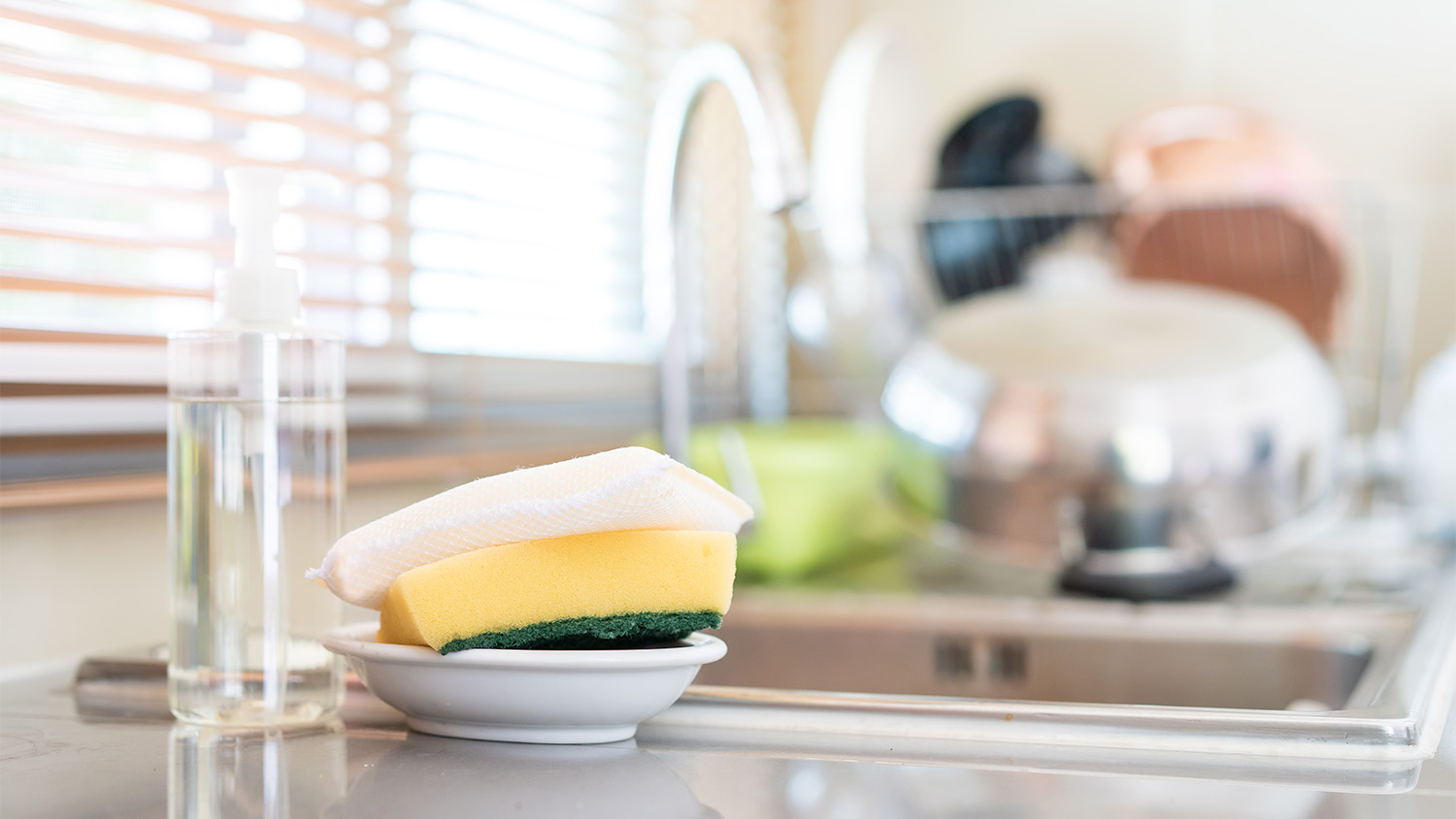
Call in the professionals when your delicate drapes need a deep clean. Let's take a look at drapery cleaning costs and which factors can sway the price tag.
A bleach solution can help you clean everything and—especially—the kitchen sink


Your kitchen is the germiest place in your home
Sponges and coffee makers are particularly laden with bacteria
Disinfect high-touch surfaces daily
A solution of bleach diluted with water is usually the most effective
You can also use sanitizing wipes and sprays or disinfecting cleaners
It’s time to flush your ideas about germs down the toilet. Contrary to popular belief, your porcelain throne isn’t the germiest place in your home. Research by the National Sanitation Foundation (NSF) found that toilets aren’t even one of the top 10 hotspots for contaminants like mold, yeast, and coliform bacteria (the family of bacteria that includes salmonella and E. coli). Instead, the largest concentration of germs is typically found in the kitchen—just like the type of dinner guest nobody wants.
That’s not to say all germs will make you sick, but you can reduce your chances of infection and foodborne illness by sticking to a regular cleaning schedule. Household germs are usually nothing a little bleach can’t handle.
Bleach is one of the most effective household disinfectants, which is why you’ll commonly find it in kitchen or bathroom cleaning products. Its active ingredient is sodium hypochlorite. This chlorine compound attacks the proteins in bacteria and viruses, damaging their structure. Once the proteins lose their shape, the cells can’t survive. Goodbye, germs.
"Bleach solutions are highly effective disinfectants for cleaning hard and non-porous materials,” said Asya Biddle, Angi Expert Review Board member and manager of The Dustbusters, a family-owned and operated janitorial company in Williamsport, PA. “Make sure to wear gloves and old clothing while utilizing the solution as it may irritate your skin and bleach your clothing."
Bleach isn’t the only effective disinfectant. You can also use:
Hot, soapy water
An EPA Safer Choice disinfecting cleaner
Sanitizing wipes or spray (which may contain alcohol or bleach)
Vinegar
The cleaning solution you choose depends on the area that needs cleaning and the types of germs you may encounter. Coffee makers work best with vinegar, but you’ll need something stronger to disinfect cutting boards that are exposed to raw chicken. Let’s discuss the six germiest places in your home and how to disinfect them.

Dish towels and kitchen sponges come into contact with just about every mess you’d find in your kitchen. It’s not surprising that they’re loaded with germs—but just how many are there? A 2017 study found 362 different bacteria species on kitchen sponges and as much as 82 billion bacteria in one cubic inch of space.
“Depending on the type of sponge, you may be able to wash it in the dishwasher and utilize it for another round of dish cleaning,” Biddle said.
Here are steps you can take to minimize bacteria and its spread:
Swap out your dish towels every one or two days
Put dish towels on a sanitizing cycle in your washing machine
Microwave wet sponges for two minutes every day (bacteria grows back quickly)
Replace sponges every one to two weeks
The kitchen sink tends to collect a lot of bacteria. Not only is it moist (which helps bacteria grow), but many people use their sinks to defrost and rinse raw meat. According to the NSF, it was the second germiest place in most people’s homes. Rinsing your sink with dish soap isn’t enough to rid it of germs, either. Instead, you should scrub your sink twice a week with one of these products:
An EPA Safer choice disinfectant
A solution of 1 tablespoon of bleach per 1 gallon of water
In addition, you should disinfect drains and disposals every month using a stronger solution of 1 tablespoon of bleach per 1 quart of water. Just mix it up, and pour it down the drain.
Note: Never mix bleach with ammonia products (because it creates a dangerous gas) or hydrogen peroxide (because it could trigger a harmful chemical reaction).
With all the foot traffic, flushing toilets, and water around the sink, bathrooms can quickly become a place where bacteria and viruses thrive. Your toothbrush holder, which the NSF cites as the third germiest place in your home, should be cleaned once or twice a week by either:
Placing in a sanitizing dishwasher (if it’s dishwasher safe)
Washing with hot, soapy water and then using a disinfecting alcohol wipe
To sanitize your toothbrush:
Soak it in antimicrobial mouthwash for a few minutes
Use a toothbrush sanitizer that’s approved by the U.S. Food and Drug Administration (FDA)
Store your toothbrush holder and toothbrushes away from the toilet bowl and sink.
Most coffee machines heat water between 195 degrees Fahrenheit and 205 degrees Fahrenheit, which is generally enough to kill bacteria like salmonella and E. coli that might end up in your drink. Nonetheless, your coffee maker is still one of the germiest spots in your home. Chalk it up to all that moisture and warmth. You’ll want to wash your carafe every day using warm soapy water or in a sanitizing dishwasher cycle. You should also wipe down handles and buttons with a sanitizing wipe or spray.
Once a month, the reservoir needs a deep clean per the manufacturer’s instructions. Some people also use vinegar (but again, check with the manufacturer). For this method:
Add 4 cups of undiluted white vinegar to the reservoir
Run a brewing cycle with the vinegar
Run subsequent brewing cycles with water until it no longer smells like vinegar
Vinegar usually works well for auto-drip and single-serve coffee makers.
Whether they’re in your bathroom or kitchen, faucet handles are high-touch surfaces that harbor bacteria, mold, and yeast. The same goes for countertops, which are often exposed to raw meat, unwashed produce, and bacteria. These require daily cleaning—especially after cooking. Wipe down your faucet handles and countertops with:
A disinfecting cleaner (make sure it works with your countertop’s material)
Disinfecting wipes or spray
A bleach solution of 5 tablespoons of bleach per 1 gallon
Additionally, you can use the same method to clean your stove’s knobs once a week.
If there’s anywhere in your kitchen that most frequently comes into direct contact with raw meat, it’s your cutting board. Some researchers even claim it’s the germiest item in your whole house, and because it’s an essential part of food prep, you’ll want to keep bacteria at bay. When you’re done cooking, disinfect your cutting board by:
Sanitizing it in the dishwasher (if it’s dishwasher safe) or scrubbing it with warm, soapy water
Then, submerging it in a solution of 5 tablespoons of bleach per 1 gallon of water
Be aware that most wood, bamboo, slate, or marble cutting boards shouldn’t go in the dishwasher. On the other hand, glass, silicone, or thick plastic cutting boards can usually be sterilized in the dishwasher. Make sure to check for a dishwasher-safe label.
Disinfecting the germiest parts in your home can feel like a big job, but having a bleach solution or sanitizing wipes on-hand can help you clean as you go. It doesn’t have to take more than a few minutes a day—make sure to pay extra attention to high-touch surfaces like knobs, handles, and pulls.
From average costs to expert advice, get all the answers you need to get your job done.

Call in the professionals when your delicate drapes need a deep clean. Let's take a look at drapery cleaning costs and which factors can sway the price tag.

Hiring a house cleaner frees up your schedule and keeps your home spotless. The cost to hire a house cleaner depends on the size of your house, your schedule, and who you hire. Use this guide to understand typical house cleaning prices better.

Discover the average acoustic ceiling cleaning cost, what affects pricing, and how to save. Get expert tips to budget for your acoustic ceiling cleaning project.

Learn how to make your home safe for little ones with this comprehensive childproofing checklist.

Protect your home from water damage with these practical gutter cleaning tips that work. Real solutions for a cleaner, safer home.

Keeping tile floors tidy is as easy as following a few simple tricks. Here’s how to keep your tile floors clean (and what to avoid).